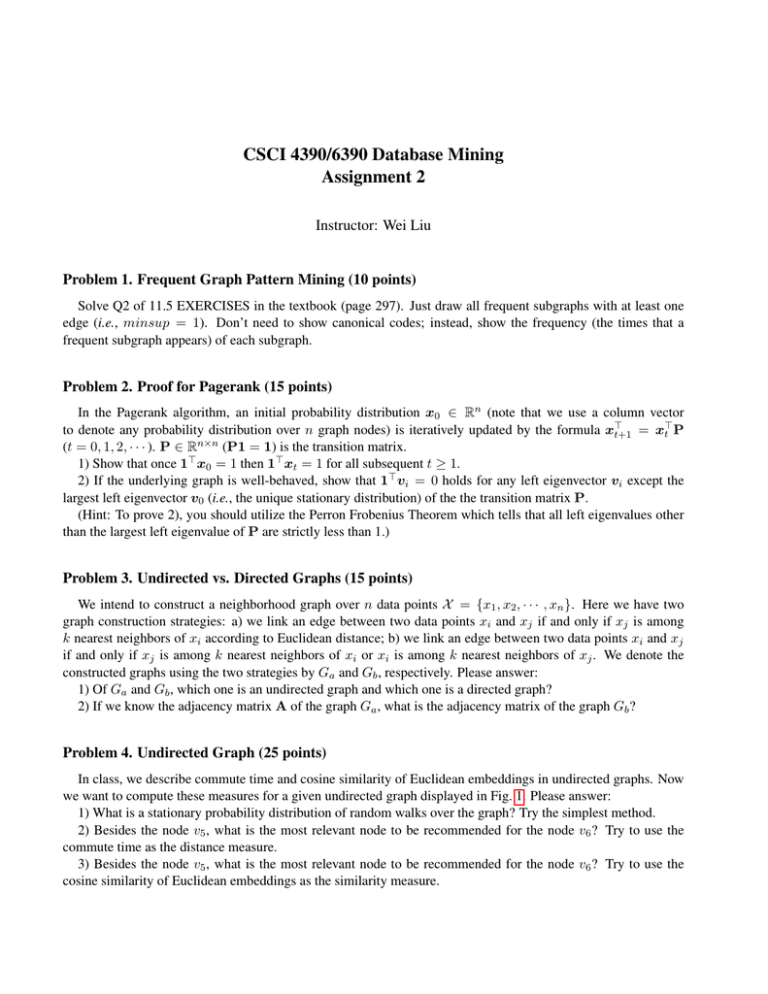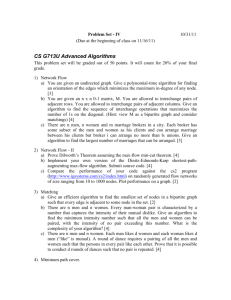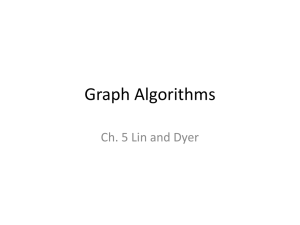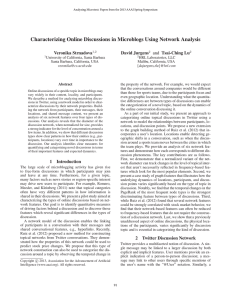CSCI 4390/6390 Database Mining Assignment 2 Instructor: Wei Liu
advertisement

CSCI 4390/6390 Database Mining
Assignment 2
Instructor: Wei Liu
Problem 1. Frequent Graph Pattern Mining (10 points)
Solve Q2 of 11.5 EXERCISES in the textbook (page 297). Just draw all frequent subgraphs with at least one
edge (i.e., minsup = 1). Don’t need to show canonical codes; instead, show the frequency (the times that a
frequent subgraph appears) of each subgraph.
Problem 2. Proof for Pagerank (15 points)
In the Pagerank algorithm, an initial probability distribution x0 ∈ Rn (note that we use a column vector
>
to denote any probability distribution over n graph nodes) is iteratively updated by the formula x>
t+1 = xt P
n×n
(t = 0, 1, 2, · · · ). P ∈ R
(P1 = 1) is the transition matrix.
>
1) Show that once 1 x0 = 1 then 1> xt = 1 for all subsequent t ≥ 1.
2) If the underlying graph is well-behaved, show that 1> vi = 0 holds for any left eigenvector vi except the
largest left eigenvector v0 (i.e., the unique stationary distribution) of the the transition matrix P.
(Hint: To prove 2), you should utilize the Perron Frobenius Theorem which tells that all left eigenvalues other
than the largest left eigenvalue of P are strictly less than 1.)
Problem 3. Undirected vs. Directed Graphs (15 points)
We intend to construct a neighborhood graph over n data points X = {x1 , x2 , · · · , xn }. Here we have two
graph construction strategies: a) we link an edge between two data points xi and xj if and only if xj is among
k nearest neighbors of xi according to Euclidean distance; b) we link an edge between two data points xi and xj
if and only if xj is among k nearest neighbors of xi or xi is among k nearest neighbors of xj . We denote the
constructed graphs using the two strategies by Ga and Gb , respectively. Please answer:
1) Of Ga and Gb , which one is an undirected graph and which one is a directed graph?
2) If we know the adjacency matrix A of the graph Ga , what is the adjacency matrix of the graph Gb ?
Problem 4. Undirected Graph (25 points)
In class, we describe commute time and cosine similarity of Euclidean embeddings in undirected graphs. Now
we want to compute these measures for a given undirected graph displayed in Fig. 1. Please answer:
1) What is a stationary probability distribution of random walks over the graph? Try the simplest method.
2) Besides the node v5 , what is the most relevant node to be recommended for the node v6 ? Try to use the
commute time as the distance measure.
3) Besides the node v5 , what is the most relevant node to be recommended for the node v6 ? Try to use the
cosine similarity of Euclidean embeddings as the similarity measure.
v2
2
2
v1
v3
2
1
3
v6
v4
2
1
v5
Figure 1. An undirected graph of six nodes, in which the weights of the respective edges are given.
v2
v3
v1
v4
v10
v5
v9
v6
v8
v7
Figure 2. A directed graph of ten nodes, in which the weight of each edge is 1.
(Hint: You should first write the graph adjacency matrix A, and then compute the graph Laplacian matrix L = diag(A1) − A. The pseudo inverse L+ is computed from the eigendecomposition of L, that is,
L = Vdiag(0, · · · , 0, σi , · · · , σn )V> . Inverting the nonzero eigenvalues and keeping the zero eigenvalues of
L give rise to the pseudo inverse L+ = Vdiag(0, · · · , 0, 1/σi , · · · , 1/σn )V> . You are suggested to use the function eig of Matlab to obtain eigendecomposition, and also handle the numerical issue by treating the eigenvalues
of small absolute values, such as |σ| ≤ 1e − 6, as zero eigenvalues. )
Problem 5. Directed Graph (25 points)
We want to implement the Pagerank method we studied in class. Given a directed graph shown in Fig. 2, please
answer:
1) What is the rank of all nodes with the importance being from high to low? Try the Pagerank method with 0.1
teleporting probability.
2) With respect to the node v2 , what is the rank of all other nodes with the relevance being from high to low?
Try the Personalized Pagerank method with 0.5 teleporting probability.
3) If the node v1 is from category a and the node v5 is from category b, what is the category (a or b) that any
other node mostly belongs to? Try the Personalized Pagerank method with 0.5 teleporting probability respectively
biased to nodes v1 and v5 .








